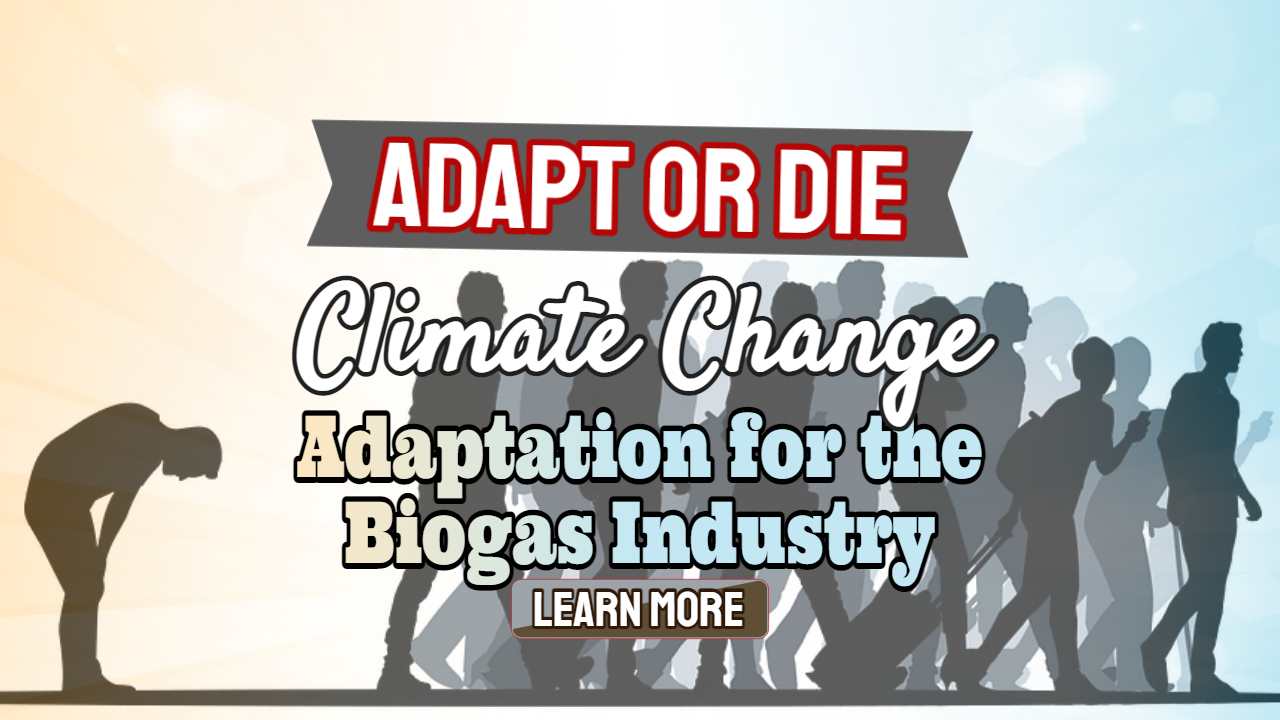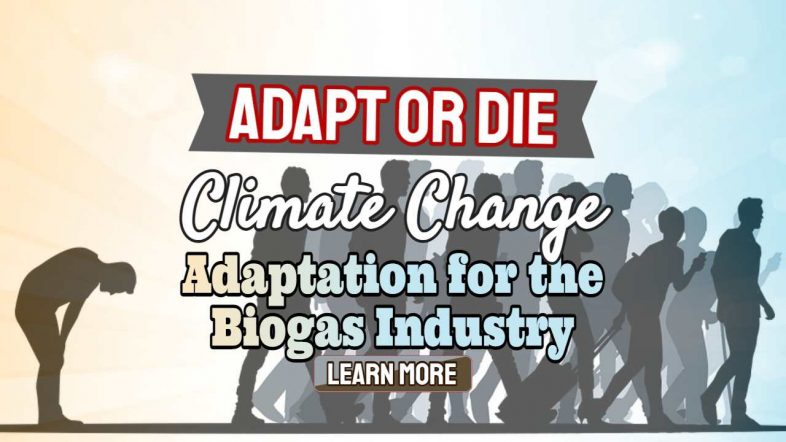Adapt or Die is all about Climate Change Adaptation and it will be an essential part of government and business strategy across all industries including for anaerobic digestion and for the biogas industry.
In all the discussions about climate change around COP26 what seems to have been forgotten is that our climate is changing and even if the global community did succeed in limiting global temperatures rising more than 1.5°, extreme weather events will still cause enormous damage.
Damage, that can only be minimised by forward-planning and adaptation. Our heading “Adapt or Die” is alarming but there is no denying that more people will die, and more species will become extinct unless we adapt.
It follows that distributed renewable energy will play a big part in future adaptation, but equally, biogas business owners also need to adapt to ensure their vital power supplies continue to function during extreme weather. Those supplies will be crucial for the communities served and with adaptation, the effects can be minimised.
What is Climate Change Adaptation?
Climate change adaptation entails taking steps to minimize the negative effects of climate change while also taking advantage of new opportunities. In order to address climate change, adaptation (responding to climatic consequences) and mitigation (cutting GHG emissions) are important components.
Who is Leading UK Government Planning for National Adaptation?
The Environment Agency (UK) has been entrusted with the duty of acting to adapt national environmental policy, plus plan and implement reasonable actions to adapt infrastructure to protect the nation from avoidable derogation and real damage from climate changes.
The Need for Climate Change Adaptation Globally
They warned in October 2021 that the only way to adequately address the climate emergency is for world leaders to focus more on adapting to the unavoidable climate repercussions that all communities were already experiencing at the time of COP26 (November 2021).
More extreme weather will lead to more flooding and drought, sea level rises of up to 78cm by the 2080s, and UK public water sources requiring more than 3.4 billion extra litres of water per day by 2050, according to a study done for the UK government.
Governments, corporations, and society have been urged to embrace and invest in adaptation rather than bear the penalties of inaction.

The Need for Climate Change Adaptation
Since COP26 the UK government has confirmed its commitment to adaptation as well as mitigation. This is appropriate due to the fact that climate adaption was one of the Summit's four core goals. But the UK EA has called for more global action to protect the billions of lives and livelihoods at danger.
Adaptation was not given much prominence at COP26 and this should be of real concern to the rest of the globe.
“The climate issue is global, but its repercussions are in your village, your store, and your house,”
said Emma Howard Boyd, Chair of the Environment Agency.
Adaptation – A New Discipline?
People will soon wonder why adaptation action isn't part of government, businesses, and communities – especially when it's much cheaper to invest early in climate resilience than to deal with the price of inaction.
Those in renewable energy, including the anaerobic digestion industry, should be considering the repercussions for their home, their farm, and their anaerobic digestion plant.
“While mitigating against climate change through decarbonization may save the world, adaptation, or the ability to prepare for climatic shocks, will save millions of lives.”

An Example of Adaptation
Simple adaptation actions which may not require much investment, and are easily implemented can have an effect way beyond the effort involved. A prime example during flooding events in the UK in the past has been that low lying electricity substations have been sited on river banks and in flood plains at risk of inundation.
As a result, large parts of major cities have been threatened with weeks of power loss, when all that is needed is adequate bunding or a power line relocation to place the substation at no more than a 2 metre or so higher location.
Global Awareness is Needed
The British government appears to have understood this but not the rest of the globe.
“Immense climatic repercussions are unavoidable, but with adequate forethought and the right action can be made far less damaging.”
If we do the right things, we can successfully address the climate emergency, but we are running out of time to put in place adequate adaptation measures. Our ideas must evolve at a faster rate than the environment.
2021 and the Disastrous Flooding in Germany
The flooding in Germany this summer claimed the lives of almost 200 individuals. That will happen sooner or later in all countries, regardless of how high the flood defences are built.
Death on that scale will occur unless we also make the locations where we live, work, and travel resilient to the effects of the more violent weather that the climate emergency is bringing.
It's either adapt or perish. We can be safer and more successful if we take the correct approach. So let's get ready, act, and stay alive.
The renewable energy industry can, and should, as a matter of self-interest, do much to ensure the resilience of their installations.
Make Preparations to Adapt
The warning is contained in the Environmental Agency's third adaptation report, which has been presented to the government in accordance with the Climate Change Act.
Despite a 2°C rise in temperature relative to pre-industrial levels, the report's primary estimates include:
- In comparison to the 1981-2000 baseline, winter rainfall is anticipated to increase by about 6% by the 2050s and 8% by the 2080s.
- In comparison to the 1981-2000 baseline, summer rainfall is anticipated to drop by about 15% by the 2050s.
- London's water level is anticipated to increase between 23 and 45 centimetres by the 2050s and 2080s.
- Flows in rivers will be more intense. Peak flows are anticipated to be up to 27% higher in the 2050s, but the river flows throughout the summer months might be 82% lower by 2050.
- If no action is taken before 2050, the public water supply will require more than 3.4 billion additional litres of water each day.
Baroness Brown of Cambridge, Chair of the CCC’s Adaptation Committee, said:
“We’re pleased to see the Environment Agency publishing its latest climate change adaptation plan.
“This road map will be critical in ensuring that our natural and built habitats are properly suited to the current and future severe changes in our climate.”
We strongly urge all government agencies, authorities, regulators, and enterprises, large and small, to complete their adaptation plans before the December 31 deadline.
“In early 2022, we look forward to evaluating the EA's proposal as part of our independent assessment for the Government of similar plans from the public and private sectors.”
All Organisations Must Take a ‘Reality Check'
‘Reality check' is a phrase that can be used to describe the situation.
The report also includes five “climate reality checks” to support the need for immediate adaptation action:
1. Businesses Need to Act for Themselves
The Environment Agency alone will not be able to protect everyone from rising floods and coastal risks:
- rising sea levels and excessive winter rains will make it impossible to protect every community technically, socially, or economically.
- Rather, in addition to building and maintaining defences, the EA will assist communities in learning to live with risk, minimise damage, and rapidly return to normal life.
2. Increased Water Scarcity
Climate change makes it more difficult to secure clean and adequate water:
- already-existing water shortages will be worsened as a result of altered temperature and rainfall patterns brought on by climate change.
- While government steps will be being taken to alleviate these constraints, a more strategic approach to water management and faster progress on improvements will be required.
3. Increased Impact of Environmental Incidents
Climate change is increasing the impact of environmental incidents;
- for example, lower river levels mean contaminants spread slower and have a bigger impact.
- To allow us and other authorities to preserve the environment, it is critical that environmental policy and legislation keep up with the rising problem.
4. Outpaced Ecosystems WILL Die
Ecosystems cannot adapt as quickly as climate change: industry and urbanisation have left the UK as one of the world's most nature-depleted countries:
- Climate change will continue to impact wildlife in England.
- Natural ecosystems have an important role in supporting life (including our own) and in our health and well-being.
- Rather than being viewed as a hindrance, nature must be understood as a vital foundation for progress.
5. Worse Environmental Events are to Come
There will be more and worse environmental events:
- climate change will exacerbate both natural and man-made environmental incidents.
- This will raise the pressure on emergency response and shift resources away from other tasks.
The Environment Agency in England has a plan. It is working with government, businesses, and communities to prepare for the effects of climate change, including implementing a record £5.2 billion flood and coastal defences programme over the next six years, according to the Environment Agency’s third adaptation report.
While the hazards are substantial, the EA claims that they can be mitigated by taking action quickly.
What the Anaerobic Digestion and Bioresources Industry Can Do for their Own Adaptability
Conduct their own adaptability review of their entire operation:
- Consider their own facility and the risks which are unique to the site location, geography, geology etc
- Consider scenarios for fire, flooding, drought, extreme heat and cold, high winds, heavy rain, snow, and hail
- Look for potential problems and pinch points and seek low-cost adaptations to remove those risks
- Open out the study to consider the locality around the AD plant or renewable energy facility for easily avoidable risks.
For the site of the installation consider whether say, if there is vulnerability to flooding, whether an existing protective bund around an AD plant created to prevent outward leakage might be raised to prevent inundation during a flash flood. This could save tens of $1,000s in repairing water damaged equipment, before even considering the loss of power and consequences on the users of the power.
Outside the site, if there is a low valley in which flooding might prevent vehicle access to the AD plant it may be possible to build up the road level less than say 1 metre to stormproof the access way.
If tall trees line a route to the AD plant consider whether they should be inspected regularly to ensure that any that might be blown onto the road in high winds are cut back or felled.
For any AD plant that depends on exporting its electricity supply to an overhead power line prone to storm damage, resilience considerations might be just one more factor to push the business to opt to invest in biomethane upgrading equipment. Upgraded biogas can be sold as CRNG (Compressed Renewable Natural Gas) trucked out in gas cylinders.
Indeed, the ultimate resilience for an AD plant operator might be to run all the business fleet on their own CNG!
EndNote:
We hope that this article has helped you to understand the concept of adaptation to climate change. We welcome your comments below.







